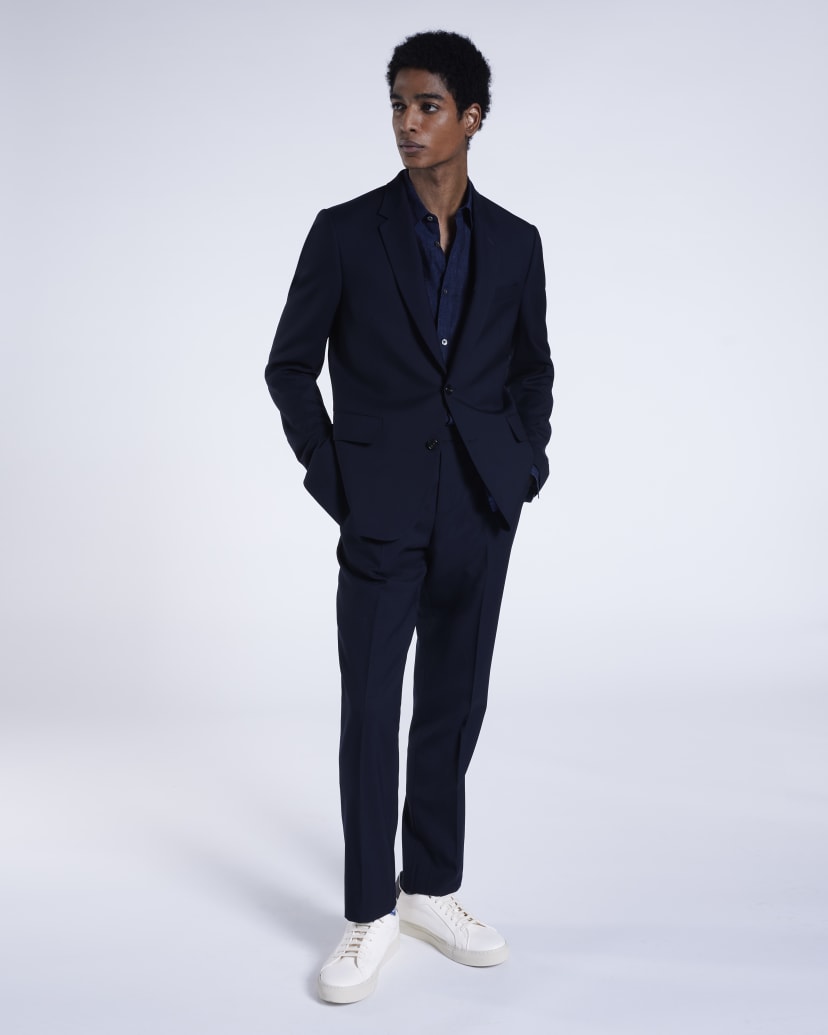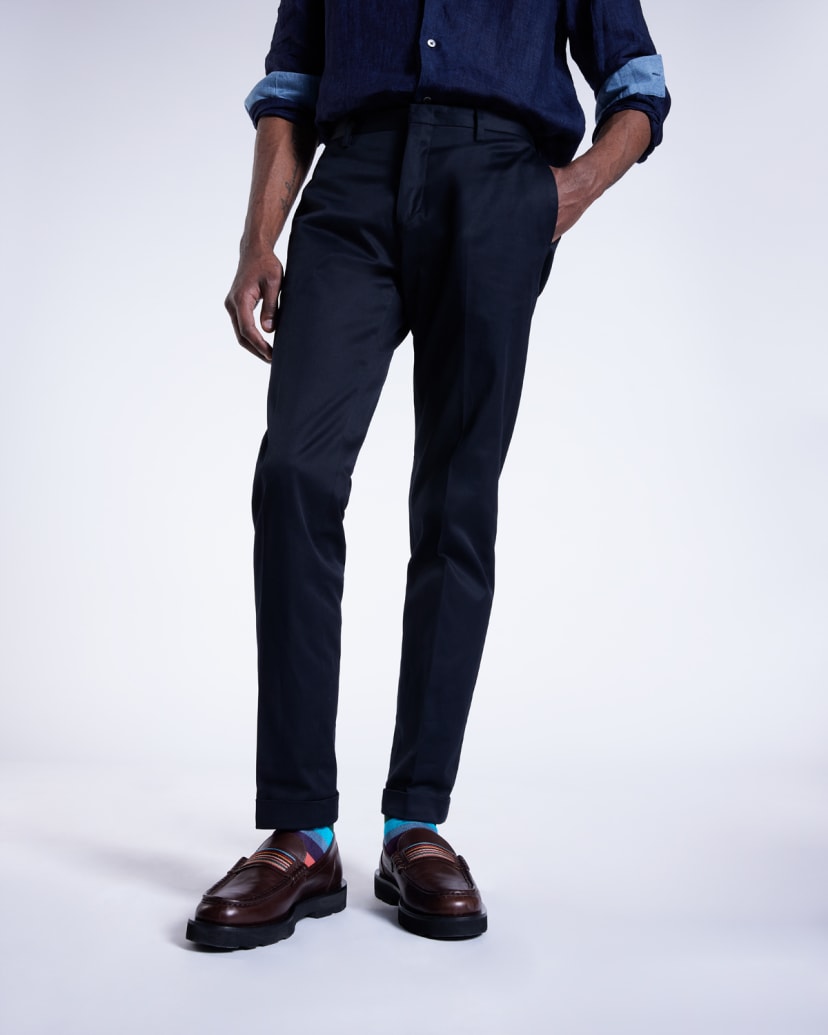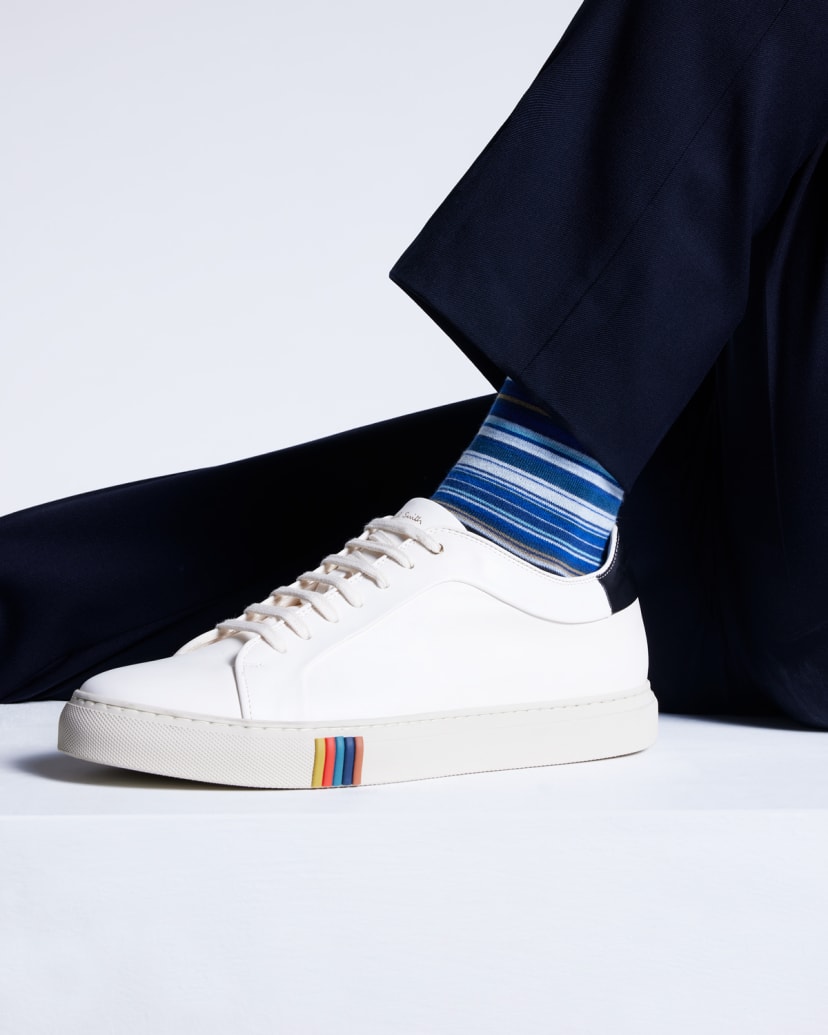
The smart casual dress code has always been one of the trickiest to crack. But it’s perhaps even harder now that office dress codes and office wear for men is more relaxed than ever. In a post-pandemic world, our workwear wardrobes are increasingly flexible, but with hybrid working and WFH now widespread, they also need to be more versatile to contend with the demands of our busier schedules.
What to wear to the office nowadays is the seemingly simple question that Paul Smith’s Modern Working Wardrobe edit aims to answer: it’s made up of a selection of pieces specifically chosen for how easily they can be mixed and matched as well as their adaptability. Here, we lay out everything you should consider when building your very own Modern Working Wardrobe, one that works for you.
Defining Smart Casual Dress Codes
“Smart casual” is perhaps one of the trickiest things to define in modern menswear. Because the short answer is “you know it when you see it”. That’s all well and good, but what actually constitutes smart casual for men, in practical terms, will depend on where you’re going, what the occasion is and what you want to ‘say’ with your outfit. For the purposes of the category addressed here – namely, office wear for men – as a rule most workplaces operate a smart casual dress code, but you’ll likely still want to err on the side of smart in this instance. For a birthday dinner with friends at a nice restaurant, on the other hand, you could likely get away with something more casual, bolder colours and even prints. These variations are something to keep in mind when you’re building the perfect smart casual wardrobe.
How To Build The Perfect Working Wardrobe?
Your focus when building the perfect working wardrobe for men should be on one key word: versatility. If you’re careful to invest in pieces you can mix and match, as well as dress up or down, you will have endless men’s office outfits and combinations to work with.
With this in mind, it’s wise to stick to a neutral colour palette when deciding on your office uniform – think along the lines of navy, black, grey, browns and khaki – with a few carefully-chosen pieces in an accent colour to add a dose of personality. Greens, oranges or terracotta, and pale blue or pink, all work well in this regard and still feel business appropriate.
Essential Smart Casual Pieces
While it would be impossible to provide a complete checklist of essential smart casual pieces for men, there are a few categories you should focus on. The first is tailoring. A good suit or two and several blazers are essential. Though, if you have a lot of meetings with clients throughout the week – on Zoom, or otherwise – you might want to consider upping that figure. Next is office shirts and polo shirts – one for each day of the week. Trousers, too, should be a mix of tailored styles and more casual iterations such as cargo trousers, cords and jeans. Then there’s knitwear: a few smart sweaters, in fine merino wool or cashmere, as well as a zip-up or zip-up variety will serve you well. The rest – jackets, coats, gilets, and tees – are where you make it your own.
Blazers vs Suit Jackets
Aside from the fact that one comes with trousers and the other doesn’t, the differences between an office suit jacket and blazer are subtle. On the whole, though, a blazer is considered a slightly less formal alternative to a traditional men’s designer suit jacket. The style of men’s work blazers nowadays also vary enormously – from the sharply-structured styles in classic navy to lightweight unstructured versions in cotton-canvas or linen and even knitted blazer varieties.
Keep in mind, though, increasingly a lot of men’s designer suits fall under the more relaxed banner. In particular, Paul Smith’s ‘A Suit To Travel In’ offers a more laidback, comfortable fit in a high-twist wool that doesn’t show creases or wrinkles even after a long day on the go or journey.
Smart Casual Suit Jacket Alternatives
Two of your first priorities when choosing the perfect men’s blazer or men’s designer suit jacket alternative should be comfort and fit: you want something that you can throw on easily for meetings that will instantly smarten up your outfit without clashing with what you’re already wearing. Also pay close attention to the lining: a fully lined blazer tends to be smarter than those unlined or half-lined varieties. Blazers aside, look also to Japanese designer workwear-inspired jackets, knitwear, especially cardigans, and technical jackets or mid-layers – which all have a well-deserved place in a smart-casual wardrobe.
Smart Casual Trousers & Chinos
While tailored trousers are the foundation of any smart-casual men’s wardrobe – there’s plenty of wiggle room here. Many of the trousers that come with Paul Smith’s ‘A Suit To Travel In’, for example, have a drawstring waistband for comfort and ease. Meanwhile, chinos might be considered the king of smart-casual staples, given they’re effortlessly easy to dress up or down. Other options here include cords, cargo trousers and even jeans, if the occasion is right.
Smart Casual Shirts For Work
There’s nothing to stop you wearing a perfectly-starched crisp white poplin shirt – the sort you’d wear with a suit – as your office shirt when you’re opting for smart casual. But you do have more flexibility and freedom when it comes to men’s work shirts and office shirts: button-down Oxford shirts are often considered a notch below on the formality scale. Other good options include grandad-collar shirts (the sort with buttons but no collar) and camp-collar shirts, which can lend a relaxed air to smart casual men’s office outfits. In terms of fabric, feel free to expand your horizons: linen and seersucker work well for summer. Whereas chambray, flannel and even denim shirts are excellent choices in the colder months.
Polo Shirts vs Classic Shirts
A more modern choice for work shirts, polo shirts have become an increasingly smart-casual popular option in recent years with good reason: they’re incredibly comfortable, but they still look slick under a blazer, sweater or jacket. There are two main categories of polo shirt for men: the lesser-spotted knitted varieties, which offer a mid-century Mad Men-esque vibe, or those made from classic cotton-pique, which is the sportier and more traditional route. What you choose will depend on where you’re wearing it, but it’s wise to have both options at your disposal. Here is also where those accent colours come into play: don’t be afraid to mix and match a coloured polo if the rest of your outfit is neutral.
Smart Casual Sweaters & Knitwear
Knitwear is another cornerstone in a smart-casual wardrobe. As well as its practical merits, the right sweater or cardigan can instantly elevate a relaxed look, dressing it up or down. Keep in mind two general rules: thinner, finer knitwear, such as those made from merino wool, tend sit on the smarter side of the spectrum, while chunkier cable-knitted styles lend a more casual air to looks. With that in mind, there’s no reason you can’t wear the former under a blazer, or swap your jacket or blazer for the latter when faced with colder conditions. If you’re looking to add a sportier, more contemporary edge to looks, then a zip-up or half-zip sweater or cardigan is your best bet.
Smart Technical Wardrobe Staples
There’s a misconception that work tailoring simply refers exclusively to office suits when the definition itself has expanded in years. Paul himself has spent his career stressing that the term encompasses not just office suits and blazers, but more relaxed forms inspired by workwear and technical pieces. These work as excellent mid-layers – which bridge the gap between outer wear and base layers and can include overshirts, field-style jackets and more.
Another popular non-tailored option in this category is the men’s gilet, the less bulky cousin of the puffa jacket, which provides a great deal of warmth under a blazer or suit jacket with none of the additional volume. When it comes to outerwear, given versatility and practicality are top priorities, look for jackets or coats in wind- and waterproof fabrics: bonus points if it’s lightweight enough to pack away in a backpack.
Should You Wear A Tie?
As dress codes have relaxed, so too has the regularity with which you wear a tie. Certainly, there are definitely still times you’ll need to wear a tie: a wedding, funeral or important business meeting or job interview. But day-to-day, you’ll find a tie is out of place in most offices. Of course, if you want to wear a tie, that’s an entirely different matter: just be sure it compliments your shirt. A vividly printed tie with a grandad collar chambray shirt is not a match made in sartorial heaven, after all. A failsafe tip is to keep a plain, wear-with-anything tie in your desk drawer or backpack, just in case you ever find yourself in need of one.
Smart Casual Accessories & Bags
It used to be that briefcases were the only work bag option available to men. Those days are thankfully over. While a traditional briefcase or folio is still a valid choice for the office – particularly for very smart workplaces or when you’re meeting important clients – there are numerous other options available nowadays. Smart-casual bags for men include backpacks, messenger bags, crossbody and tote bags: the only thing to keep in mind is that your chosen bag needs to be large enough to accommodate a laptop. That, and the fabric. If you have a long commute where you’re likely to be changing trains, for example, you might want to opt for a waterproof in a technical material to withstand a bit more wear and tear than leather.
Other smart-casual men’s accessories include belts (leather, woven and technical are all acceptable), scarves and gloves. Jewellery, too, is also increasingly worn to the office, but keep it to one or two pieces and opt for understated styles.
Smart Casual Shoes & Sneakers
Unless you’re wearing a classic men’s designer suit, there’s no need to wear your smartest dress shoes to the office these days; in fact, very smart shoes like Oxfords, brogues or monk straps will look out of place when worn with more casual looks. Instead, look to more laidback options: suede desert boots, leather Chelsea boots or loafers are all great (and more comfortable) picks.
Smarter sneakers – in plain white or black – are also a very versatile option for the office and otherwise. Paul Smith’s Basso, Miyata, Rex, Lee and Hansen styles all fit the bill. Given that you can wear them with a blazer and shirt as well as with more dressed down looks, you’d be surprised how easily they can be worn day to night.
Discover More
Do you want to keep in touch?
Published: 03.23
Words: Molly Isabella Smith
Photography: Ollie Thompson











